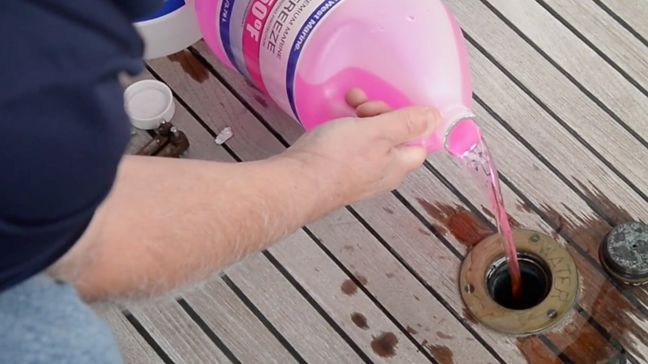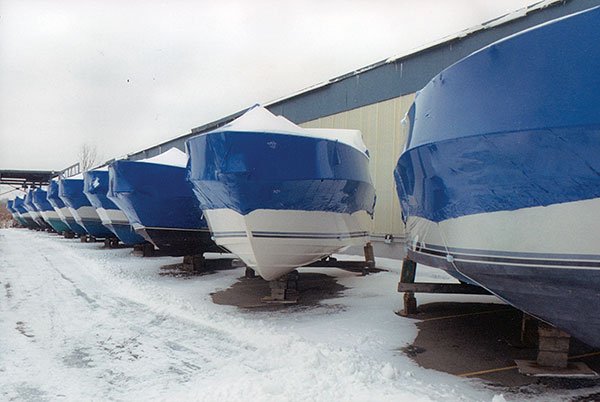As winter begins throughout the northern United States & Canada, it's essential to prepare your boat for the harsh, freezing temperatures ahead. Properly winterizing your boat can protect it from costly damage and ensure it's ready to hit the water when the warmer months return. In this guide, we’ll break down everything you need to know about winterizing your boat—from the steps involved to the tools and products you’ll need.
Key Takeaways
- Learn why winterizing your boat is a must to prevent costly freeze damage and extend the life of your vessel.
- Discover the essential tools, products, and steps involved in properly preparing your boat for off-season storage.
- Understand what can go wrong (and how expensive it can get) if you skip winterization altogether.
- Get a realistic breakdown of the time and cost involved, whether you DIY or hire a pro.
- Find out exactly when to winterize and how to do it right with our detailed, step-by-step guide.
What Goes Into Winterizing a Boat?
Winterizing your boat means preparing it to endure freezing temperatures while in storage. This involves draining water, adding antifreeze to prevent freezing, and using special oils to protect various internal components. It also includes cleaning, covering, and storing your boat in a way that shields it from the elements. Each of these steps prevents damage to the engine, plumbing, and hull during cold months on the hard. By following a thorough winterization process, you can save yourself from costly repairs when the boat is back in the water.
What Happens if You Don’t Winterize Your Boat
Failing to winterize your boat can result in severe damage. Water left in the engine or plumbing systems can freeze, expanding and cracking pipes, hoses, and even the engine block. Corrosion and rust may also form on parts of the engine, leading to decreased performance or total failure. Additionally, fuel can deteriorate and clog your system. A boat that’s not winterized properly could require thousands of dollars in repairs, and in extreme cases, you might need to replace major components.
Here are some of the specific risks that can occur when winterization is neglected:
- Engine block damage: Water expands when frozen—if it’s trapped in the block or cooling system, it can crack cylinder heads or exhaust manifolds.
- Burst plumbing lines and tanks: Any water left in freshwater or waste systems can freeze, leading to burst hoses or cracked fittings.
- Fuel breakdown and clogs: Untreated fuel can degrade over winter, leaving deposits that clog fuel lines and carburetors.
- Battery damage: Freezing temperatures can permanently damage or reduce the lifespan of lead-acid marine batteries.
- Mold, mildew, and interior damage: Moisture left behind and poor ventilation can lead to mold growth, warped cabinetry, and foul odors come spring.
- Corrosion and metal fatigue: Saltwater residue or moisture inside the engine bay or hull can accelerate corrosion on key components.
- Hull and deck cracking: Ice buildup around the hull or freezing in deck cracks can damage fiberglass, gel coat, or hardware.
- Reduced resale value: A boat with signs of freeze damage will fetch far less on the market than one that’s been properly maintained.
What Is the Cost of Winterizing a Boat?
Winterizing a boat typically costs between $300 and $1,000, depending on whether you do it yourself or hire a professional.
The cost of winterizing a boat can vary depending on your approach:
- DIY winterization may save money, but it requires time, effort, and access to the proper tools and materials.
- Professional winterization services cost more upfront but ensure all critical systems, like the engine, plumbing, and fuel lines, are properly handled.
- While the service cost may seem high, investing in winterization helps prevent costly damage like cracked engine blocks or burst pipes.
- In the long run, proper winterizing is a smart and cost-effective decision for any boat owner looking to protect their investment.
Winterization Time
How long does it take to winterize a boat?
- If you’re doing it yourself and have all the tools and products ready, you should set aside about 2 to 4 hours for a thorough winterization.
- First-timers might take a bit longer, especially when learning how to flush systems or drain fluids properly.
- For professionals, the job typically takes about 1 to 2 hours, depending on the size and type of boat.
- The more systems your boat has (freshwater, head, inboard engine, generator, etc.), the more time you’ll need to do it right.
Winterization Timing
When to winterize a boat?
- The best time to winterize your boat is before the first hard freeze hits your area.
- As a general rule, most boaters aim for mid to late fall, usually October or early November, depending on your region.
- If your boat will sit unused for more than a month in temperatures below freezing, it’s time to winterize.
- It’s better to winterize a little early than too late; just one cold snap can cause costly damage if your systems aren’t protected.
What Products Do I Need to Winterize a Boat?

Winterizing a boat requires specific products that will protect your boat’s engine, fuel system, and other parts from freezing temperatures. Here’s a breakdown of essential products needed:
Antifreeze
- Antifreeze is used to protect your boat's engine and plumbing from freezing.
- It’s vital for preventing cracks in pipes and the engine block caused by ice expansion.
- Be sure to use marine-grade, non-toxic antifreeze (not automotive) and flush it through your freshwater systems, bilge lines, and engine cooling system after draining out the water.
Fogging Oil
- Fogging oil is sprayed into the engine's cylinders to coat and protect internal components from rust and corrosion during the winter months.
- This step is especially helpful for outboard and inboard gas engines that will sit unused for a while.
- It creates a thin protective layer inside the engine so you’re not dealing with damage when you fire it up again in spring.
Motor Oil
- Replacing motor oil before storage ensures old, dirty oil doesn’t sit in your engine all winter, which could lead to damage and corrosion.
- Old oil can carry moisture and acids that break down internal engine parts over time.
- Make sure to run the engine briefly before draining the oil. Warm oil flows better and carries out more impurities.
Fuel Stabilizer
- Fuel stabilizer prevents fuel from breaking down, which can clog your fuel system and reduce engine efficiency once you’re ready to use your boat again.
- Add it to your fuel tank while the engine is still running so it circulates through the entire system.
- This step helps avoid hard starts and gummed-up fuel lines when spring comes around.
Oil Filter
- A new oil filter ensures that contaminants are kept out of your engine during winter storage, protecting your engine from corrosion.
- It’s a simple step that pairs with your oil change and keeps your new oil clean when you start the boat back up.
Oil Suction Pump
- An oil suction pump makes it easier to drain the old motor oil before adding fresh oil for storage.
- This tool is especially helpful for tight engine compartments where draining oil from below is a pain.
- If you're doing your own winterizing, this tool can save you a ton of time and mess.
Lubricant and Drain Plug Gaskets (Outboard Lower Unit)
- Changing the lube and drain plug gaskets in the lower unit helps prevent water from entering the gear case, which can freeze and cause damage.
- Gearcase oil can get contaminated with moisture over the season, so draining and replacing it now helps protect those internal gears.
- Always check for milky oil when draining; it’s a sign water got in.
Lubricant Injection Pump (Outboard Lower Unit)
- This tool allows you to inject new lubricant into the lower unit of your outboard motor, ensuring all components are protected during winter.
- The pump draws gear oil from the bottom up, preventing air pockets and ensuring a full fill.
- It’s a small detail that makes a big difference in keeping your lower unit running smoothly year after year.

How to Winterize a Boat: Your Winterizing Checklist
Now that you have the necessary tools and products, here’s a step-by-step guide on how to winterize your boat:
Replace Engine Oil
Drain the engine oil and replace it with fresh oil to prevent corrosion and ensure that the engine is lubricated during storage.
Flush and Drain Water From Your Engine
Remove all water from the engine cooling system to prevent freezing. This step is essential for avoiding cracked engine blocks and pipes.
Add Stabilizer Fuel
Add fuel stabilizer to your gas tank and run the engine for a few minutes to circulate it through the system. This keeps the fuel from breaking down and gumming up your engine.
Protect Internal Engine Components
Use fogging oil to coat the internal parts of your engine, preventing rust and corrosion while the boat is in storage.
Replace Gear Oil
Drain and replace the gear oil in the lower unit to ensure that your gears are properly lubricated and protected from water contamination.
Lubricate Grease Fittings
Apply marine grease to grease fittings and other moving parts to prevent corrosion and ensure smooth operation when your boat is back in use.
Remove Valuables
Anything that can be easily removed from the boat that is at risk of damage from moisture or freezing, it is always best to remove it and take it home to guarantee it stays warm and dry.
Flush Water & Holding Tanks
Make sure to fully empty all water and holding tanks on the boat, and fill with marine grade antifreeze. Run faucets, flush toilets, and run the macerator pump briefly to ensure that antifreeze reaches all the lines and tanks aboard.
Clean and Wax
Thoroughly clean and wax your boat’s exterior to protect the hull from dirt, grime, and moisture buildup over the winter months.
Cover and Storage
Use a high-quality boat cover to shield your vessel from the elements, and store it in a dry, sheltered location if possible. Proper coverage is crucial to prevent mold, mildew, and weather-related damage.
Other Important Steps for Winterizing Your Boat
These last few steps are often overlooked, but they’re just as important for a full winterization:
- Inspect steering and throttle controls: Make sure your steering and control cables move freely and aren’t binding or sticking. Any stiffness could be a sign of wear or moisture intrusion.
- Clean the flame arrester: If you have an inboard engine, remove and clean the backfire flame arrester. A quick cleaning now can help maintain airflow and prevent fire hazards.
- Look for signs of leaks: Walk around the boat and inspect through-hull fittings, hoses, and seals for any signs of water intrusion or wear. Catching it now can save you a spring headache.
- Check your owner’s manual: Every boat has its quirks. Flip through your manual to make sure you’re not missing anything specific to your model when it comes to off-season prep.
Final Thoughts
Winterizing your boat is an essential part of routine maintenance that prevents costly damage during the off-season. The steps outlined in this guide will protect your engine, fuel system, and hull from freezing temperatures and harsh winter weather. Preparing your boat for winter will save you time, money, and hassle when the next boating season arrives. While winterization is critical for cold-weather months, regular maintenance applies year-round to keep your boat in top condition. Be sure to explore our guides to maintaining bow & stern thrusters, windlass maintenance, and how to prepare your boat in the spring after winterizing.